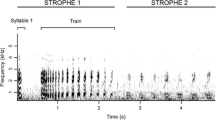Abstract
Large body size confers a competitive advantage in animal contests but does not always determine the outcome. Here we explore the trade-off between short-term achievement of high social status and longer-term life history costs in animals which vary in competitive ability. Using laboratory mice, Mus musculus, as a model system, we show that small competitors can initially maintain dominance over larger males by increasing investment in olfactory status signalling (scent-marking), but only at the cost of reduced growth rate and body size. As a result they become more vulnerable to dominance reversals later in life. Our results also provide the first empirical information about life history costs of olfactory status signals.
Similar content being viewed by others
Author information
Authors and Affiliations
Additional information
Received: 15 December 1999 / Revised: 6 June 2000 / Accepted: 24 June 2000
Rights and permissions
About this article
Cite this article
Gosling, L., Roberts, S., Thornton, E. et al. Life history costs of olfactory status signalling in mice. Behav Ecol Sociobiol 48, 328–332 (2000). https://doi.org/10.1007/s002650000242
Issue Date:
DOI: https://doi.org/10.1007/s002650000242




